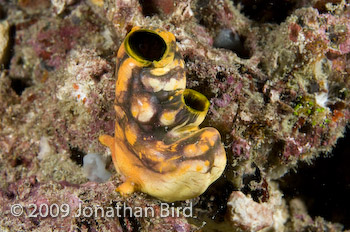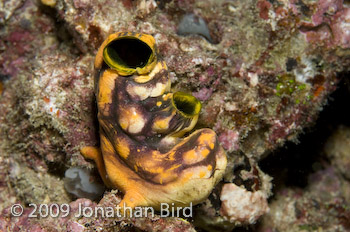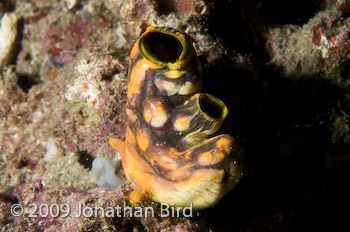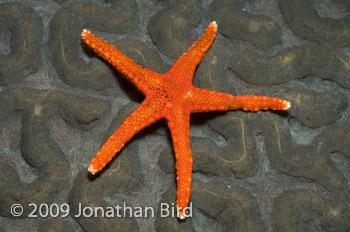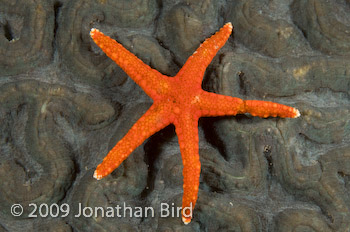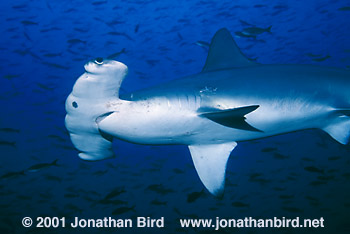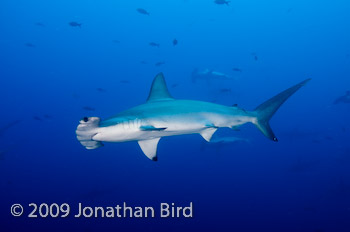
| One Strobe or Two? Jonathan Bird By virtue of economics, most underwater photographers start out with a single strobe. The problem with a single strobe is that, although it does a fine job of illuminating one side of the subject, it leaves the other side of the subject in shadow. If you position the strobe close to the camera lens (or port), the shadow will fall behind the subject, largely out of view to the camera. Unfortunately, that is also the position which best illuminates "backscatter"--particles suspended in the water that reflect light back to the lens from the strobe, creating a "snowstorm" effect. To reduce the effect of backscatter, which is a discussion all unto itself, the best course of action is to get the strobe as far as reasonably possible from the lens. In theory, backscatter should be at it's minimum when it is illuminated at a right angle to the line of sight from the lens--i.e. side lit. Of course the problem with that is the strobe will cause the subject to throw a shadow right across the image. It will look terrible! The solution of course is to add another strobe, on the other side of the subject, to cancel out the shadow from the first strobe. Now you have the backscatter being illuminated at oblique angles, and uniform illumination of the subject across the image. If you use two identical strobes on the same power setting, at the same distance away from the subject on each side, you get near perfect cancellation of the shadows. This is often called flat lighting or equal power lighting. Many photographers, myself included, often like the look of flat lighting. If you reduce the light level from one of the strobes, you get some shadows, but not the harsh shadows of a single strobe. The fill strobe softens the shadows of the primary or key strobe. This form of lighting is sometimes called ratio lighting. A typical ratio is 2:1-meaning that the primary strobe is twice as powerful as the fill strobe (or, the fill strobe is 1/2 the power--1 stop dimmer--than the primary strobe), This can be accomplished in manual exposure by simply turning the fill strobe down a power setting from that of the primary strobe. In TLL, it is most easily accomplished by adding a diffuser to the fill strobe, or by backing it up from the subject further than the primary strobe. 1.4x the distance will give you 1/2 the light. You can round this to 1.5 for convenience. So if the primary strobe is 1 foot away, the fill strobe is 1.5 feet away. The reason for this lies in the mathematics...the area illuminated by the strobe increases as a square of the distance. Doubling the distance from the strobe to the subject throws the light from that strobe over 4 times the previous area, effectively reducing its power by two stops. Many photographers feel that ratio lighting looks more natural and gives more texture to a subject than flat lighting. I like to try it both ways, depending on the subject. Some macro subjects, like corals, sponges, and other "textured" subjects really benefit from ratio lighting because the soft shadow helps bring out the texture. Others subjects, like crabs and anemones, don't benefit from this lighting technique because half the animal is still too dark to have detail, even if the shadow is not harsh. You just have to try them both and see which looks better to you. Unquestionably, two strobes are better than one when it comes to macro photography because in macro photography, nearly all the light to illuminate the subject typically comes from the strobe, and the strobe is close to the subject, creating harsh shadows. The second strobe allows the photographer to light the subject fully, controlling shadows, while at the same time minimizing backscatter. The role of ambient light is not usually important except perhaps as background water color. What about wide angle? Many photographers mistakenly believe that two strobes are more important for wide angle than for macro, because wide angle scenes need more light (the subject is further away) and more coverage (the lens is so wide, one strobe won't cover it all). This is not really true at all. A proper wide angle strobe, such as an Ikelite DS-160 or 200 has a coverage wide enough to handle a 100 degree angle-of-view lens, if aimed properly. And while it is true that the subject is often further away in wide angle photography than it is in macro photography, it is also true that in wide angle photography, ambient light is usually part of the image. Your goal in wide-angle photography (most of the time) is to match the light from your strobe(s) to the ambient light, to create an image that looks natural. So you end up opening the aperture to get some ambient light in the image, and the strobe just doesn't need to fire at full power. I will rarely find myself shooting on full power unless the ambient light is quite bright (because I'm shallow) or if the subject stays pretty far from my lens (such as skittish sharks). In fact, because ambient light can be considered your "fill" light, you often can get away much better with a single strobe in this situation than you can in macro work. Many wide angle subjects, such as sharks against blue water, don't really throw a shadow, except maybe a pectoral fin against the body. So you don't gain a whole lot from two strobes. Furthermore, a small shadow might be more acceptable to the viewer's eye in a wide angle photo because we are used to seeing shadows being cast in real life by large objects illuminated by the sun. Does this mean that I advocate a single strobe for wide angle? Nope. I always prefer the lighting options I gain by having two strobes all the time. However, there are situations, such as fighting the current in the Galapagos, that I will decide that my subject doesn't require two strobes as much as I need to reduce my swimming effort-so I'll remove the second strobe arm/strobe. You can get by with one strobe if that's all you have, but the fact is that if you have a choice, you should almost always be shooting with two. |
Examples
Here is an example of using a single strobe for wide angle when two would have been better. However, because of prevailing currents, I stuck with a single strobe to make the camera easier to handle. Note the harsh shadow cast by the pectoral fin, but other than that, the single strobe illuminates pretty well.
A similar shot using two strobes--note no harsh shadows on the pec fin. |
Last Update 11/17/09
